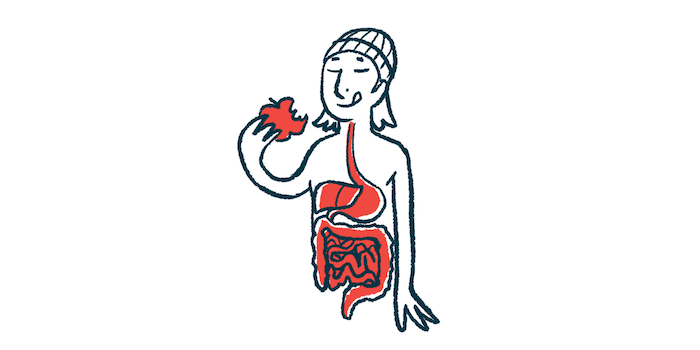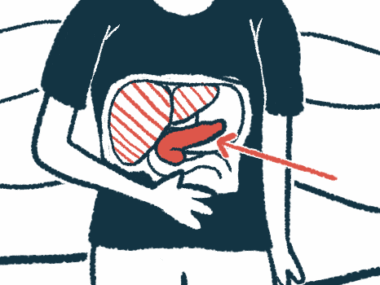CF-related diabetes linked to higher GI symptom burden: Study
CFRD patients had more issues with appetite, acid reflux
Written by |

Cystic fibrosis (CF) patients with CF-related diabetes (CFRD) had a higher gastrointestinal (GI) symptom burden than patients who didn’t have it, a U.K. study found.
CFRD patients had more symptoms related to appetite and gastroesophageal reflux disease (GERD), more commonly known as acid reflux or heartburn, as well as more nausea and bloating.
The study, “reveals for the first time, that people with CF and CFRD have a particularly high prevalence of GI symptoms,” the researchers wrote in “Diabetes is associated with increased burden of gastrointestinal symptoms in adults with cystic fibrosis,” which was published in the Journal of Cystic Fibrosis.
The thick, sticky mucus that builds up in CF can affect the pancreas, leading to impairments in producing insulin, the hormone that helps clear sugar (glucose) from the bloodstream, and to insulin resistance, a poor response to the hormone.
CFRD — marked by high blood sugar levels — is a common complication of CF, occurring in about 40-50% of adult patients.
Diabetes is also common in the general population, where it has been linked to GI symptoms such as nausea, vomiting, reflux, and bloating, among others.
While CF is also marked by significant GI symptoms for many patients, whether CFRD itself contributes to those symptoms hasn’t been established, leading researchers to compare GI symptoms in a subset of CF patients with or without CFRD who completed a GI symptom questionnaire as part of a larger observational study at four U.K. care centers.
Comparing GI symptoms with or without CFRD
All 88 participants had pancreatic insufficiency, a common manifestation of CF when the pancreas doesn’t release enough of the enzymes needed to digest food. The patients were not using CFTR modulator therapies.
Most (69%) didn’t have CFRD, but 31% did. The CFRD group was composed of significantly more women and were more likely to use laxatives and H2 blockers, a class of medicines that reduce stomach acid. They also required more into-the-vein antibiotics in the last year.
The questionnaire, called the CFAbd- Score, contains 28 questions related to five domains: abdominal pain, bowel movements, eating/appetite, GERD symptoms, and impact of GI symptoms on quality of life. Higher scores reflect a greater symptom burden.
While patients overall exhibited a high GI symptom burden, it was significantly higher among those with CFRD, results showed. People with CFRD had a mean total CFAbd score of 25.4 compared with 18.4 in the other group.
CFRD patients also had significantly higher scores in the GERD and appetite domains. Using H2 blockers, regardless of CFRD status, was associated with increases in GERD symptoms and bowel movement symptoms.
While neither CFRD nor H2 blockers alone were associated with an impact on GI-related quality of life, there was a significant interaction between the two. In other words, GI symptoms had a greater impact on quality of life for those with CFRD who were also using H2 blockers than they did for CFRD patients not using the blockers or with non-CFRD patients.
Specific symptoms common among diabetes patients in the general population include abdominal pain, bloating, heartburn, acid reflux, nausea, vomiting, constipation, loose stool, and three or more bowel movements a day.
A greater percentage of CFRD patients than non-CFRD patients reported having all these symptoms except for loose stools four to seven times over the past two weeks. Only bloating and nausea occurred at significantly higher rates in the CFRD group.
Other symptoms that are not as typical in diabetes appeared differently between the groups, but were not statistically analyzed and should be evaluated in later studies, the researchers noted.
“To our knowledge, this is the first study to identify a higher prevalence of GI symptoms in people with cystic fibrosis-related diabetes compared to those without,” the researchers wrote, adding, “the combination of diabetes with CF may be accentuated in the presence of both pathologies and further drive symptoms.”
They said the findings emphasize “the value of comprehensive GI symptom assessments to identify pwCF [people with CF] particularly at risk so that they can receive appropriate support and GI management.”
More research is needed to better describe the differences, and to “investigate the underlying causes and implement appropriate treatment strategies,” the researchers said, adding the potential impact of CFTR modulator therapies and the effects of the duration of CFRD on GI symptoms should also be investigated.







